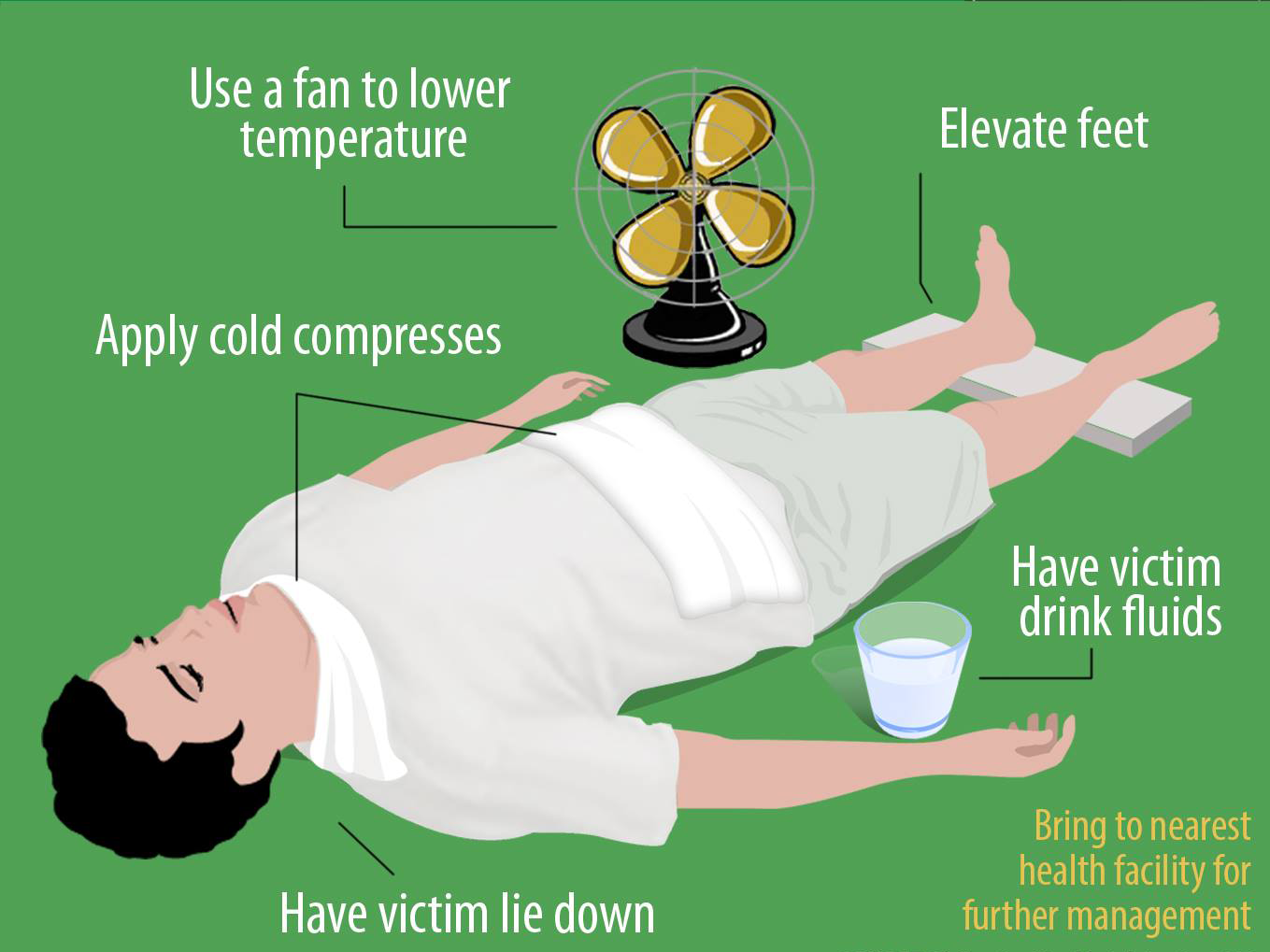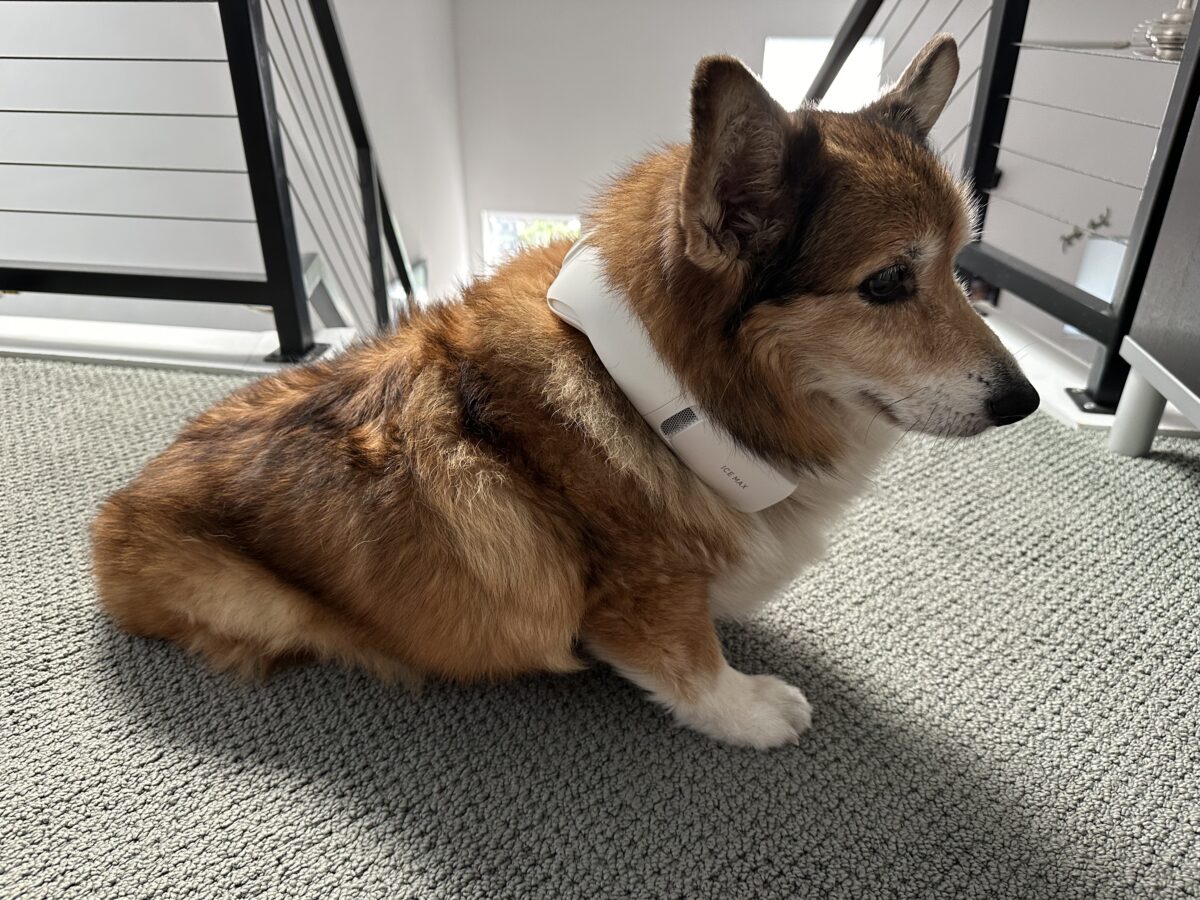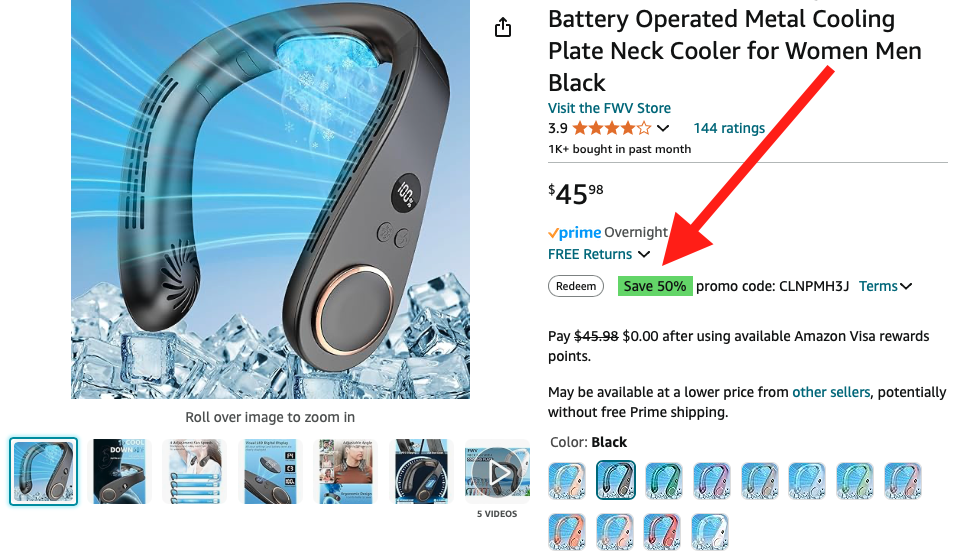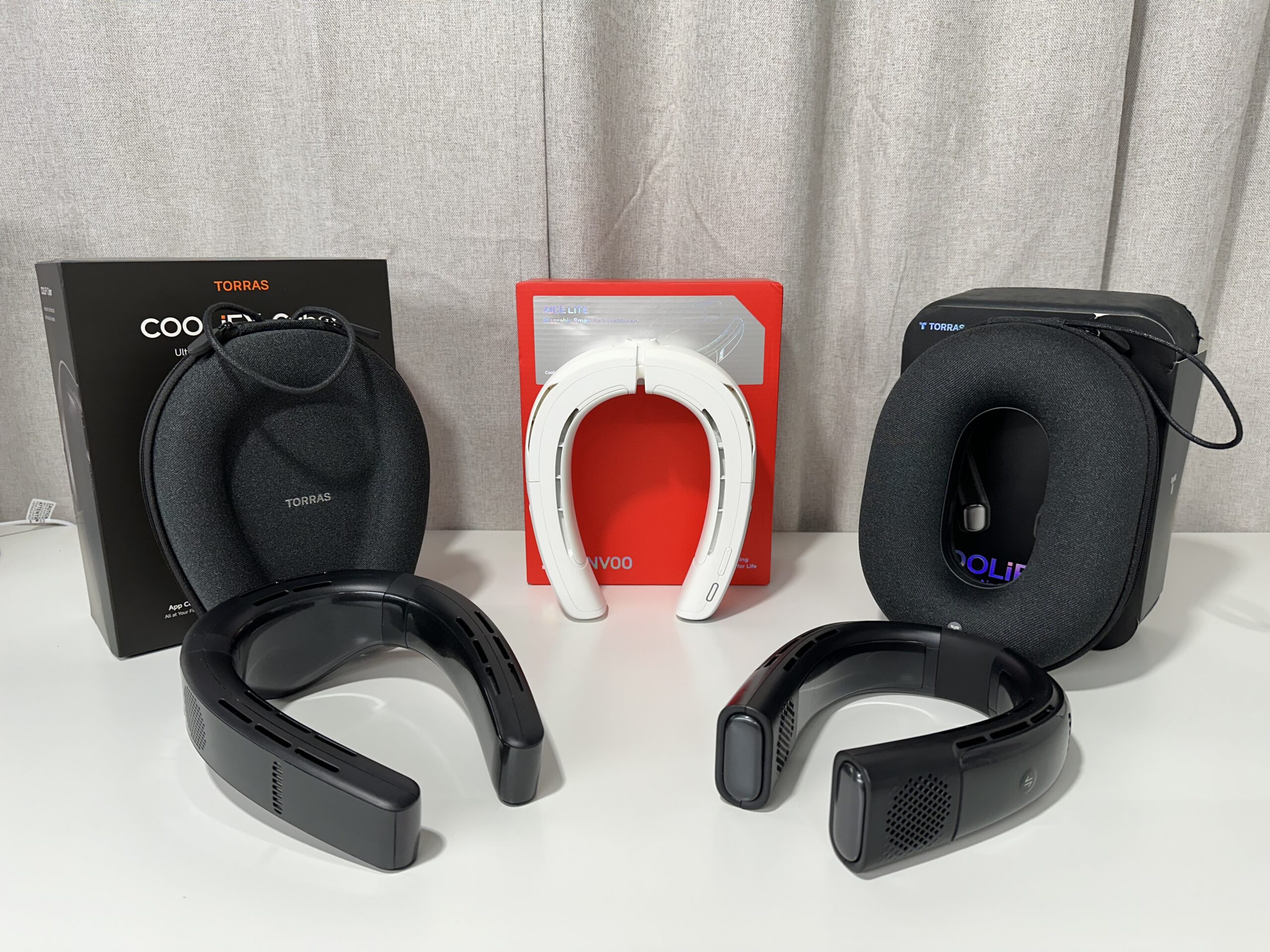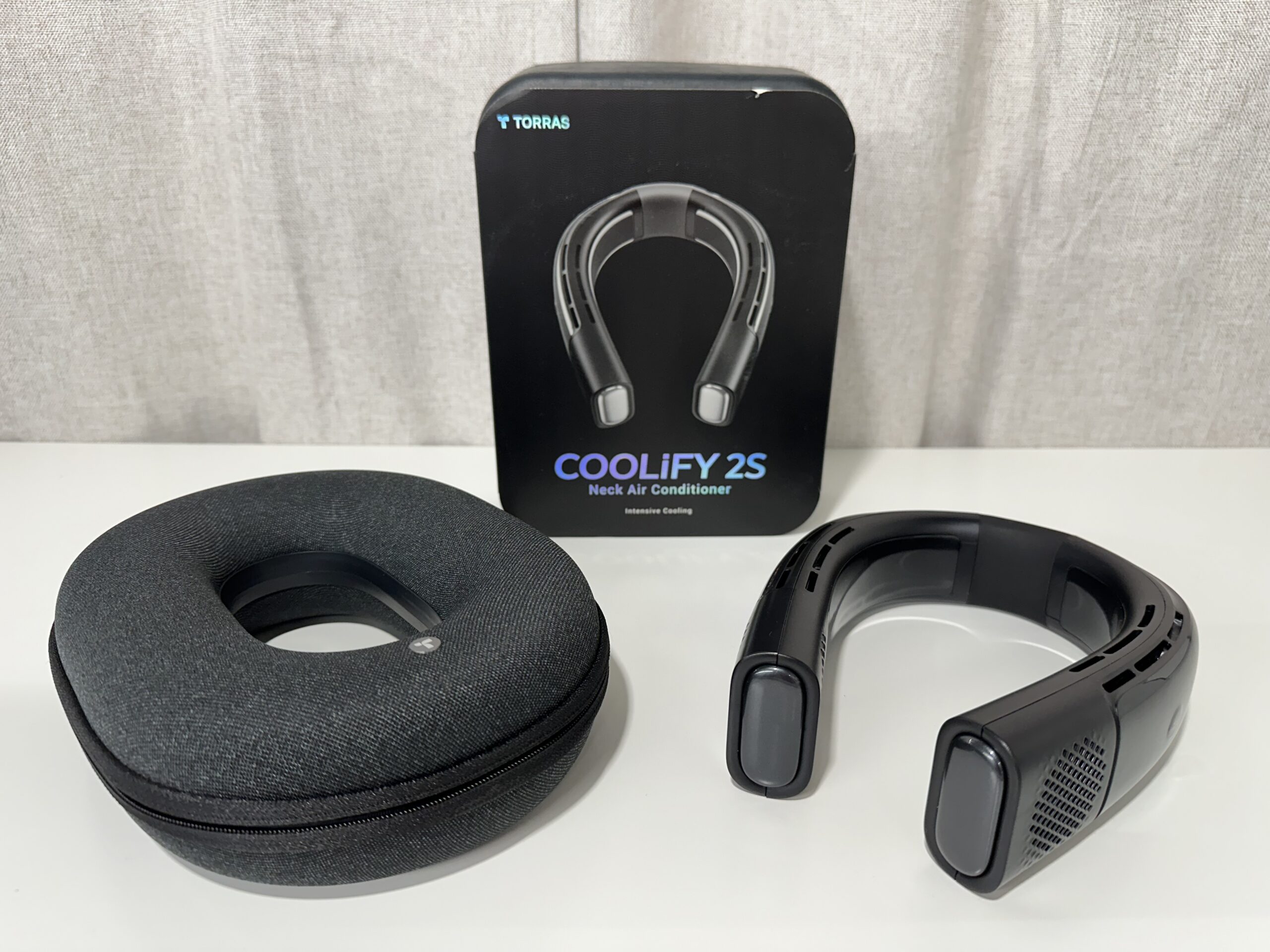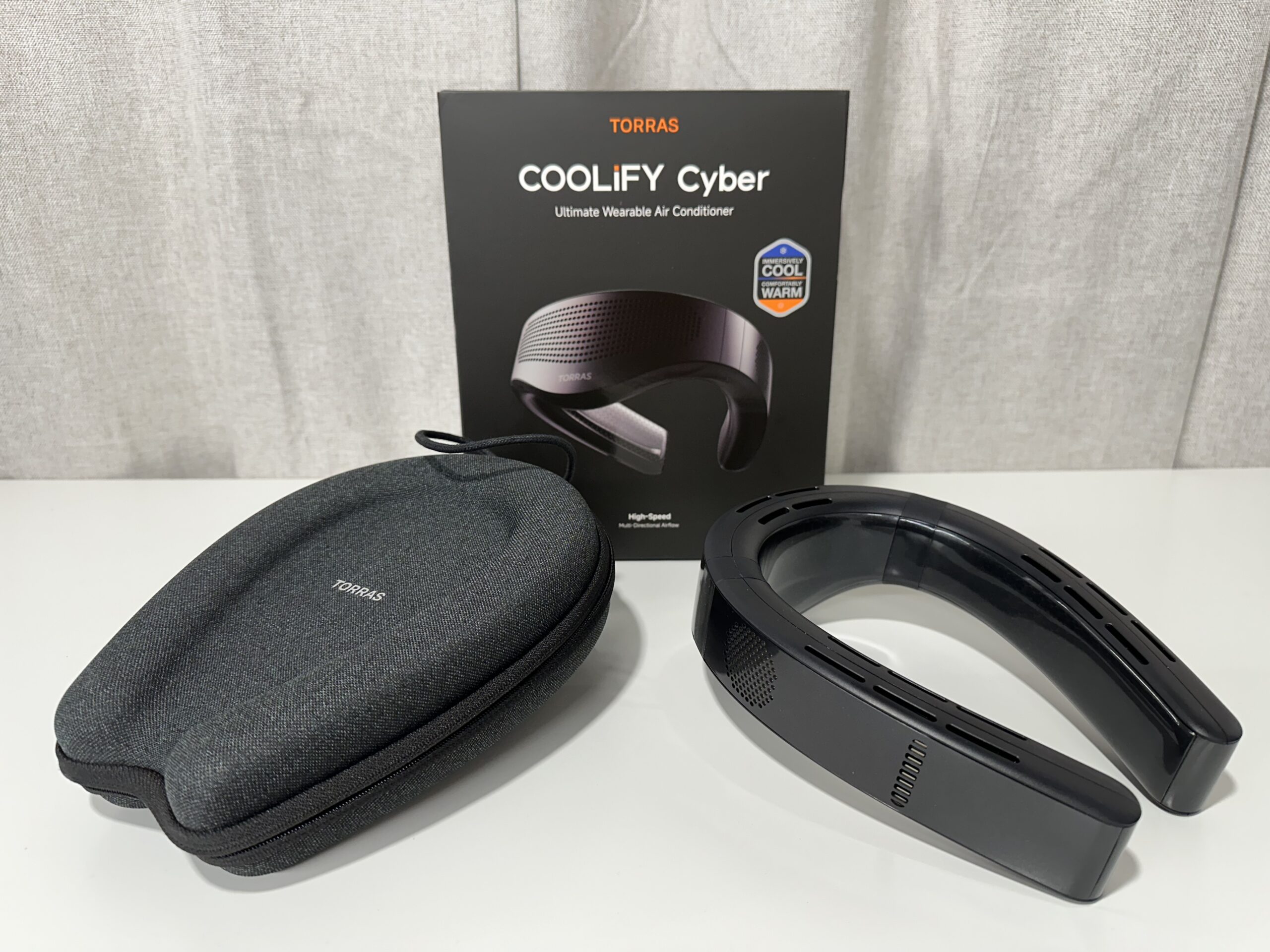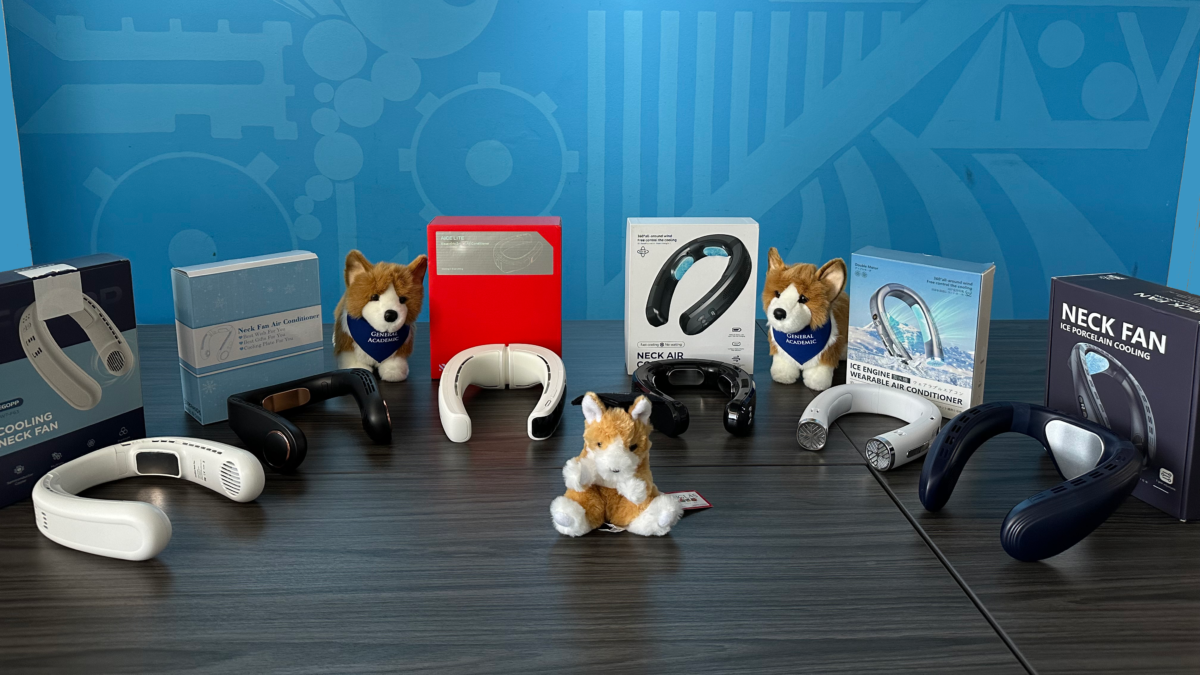
Only commercialized within the last few years, thermoelectrically-cooled neck fans promise to keep you comfortable indoors and outdoors. They look like a pair of nice headphones draped around the neck and work like a combination of a cold towel and misting fan. While our thorough testing during a Houston summer found them generally helpful indoors, they were much less so outside.
General Academic’s Associate Manager for tutoring operations was born and raised in South Dakota, and Sam’s four years at Rice University somehow didn’t acclimate him to the Texas heat. He is always hot. Even when he’s seated directly under one of the Study Lounge’s three, commercial air conditioners, he’s likely to be on the verge of sweating.
So being the meticulous and caring company that you know us to be, we decided to apply that same sense of scientific rigor and innovative thinking to help improve Sam’s life, especially given this summer’s early heat dome, high humidity, and post-hurricane power losses.
We Tested 10 Different Neck Fan Models
After reviewing 10 models ranging in price from $28 to $280, we’re excited about the future of this wearable tech especially as the Texas heat rises. However, while cooling neck fans are effective at personalizing comfort for indoor use, they struggle to keep up outside when the temperature rises above 90 degrees. At even this moderate (for Texas) level of heat, their cooling plates become barely perceptible against your skin.
Given their limited effectiveness outdoors in moderate to extreme heat, our 10 point rating scale doesn’t see any cooling fan model score above an 8, but you do seem to get what you pay for. The under-$100 models didn’t score above a 6 (barely improved our lives) while the $175+ models are universally more effective, quieter, and better built.
Neck fans are part of the relatively new tech category of “wearables,” and you should research them just like you would their less-electric analogues—try them on. While our team and friends generally agreed that the expensive fans were better, they didn’t alway agree on why they were better or which particular luxury model they liked the most.
For example, one nice model, the Torras Coolify 2s has the potential to blow more air into the wearer’s face, generating a gentle, wind-like rumble across the ears. This may be a positive for you if you like that feeling on your cheeks or a big negative if you dislike the noise. However, depending on your specific neck and ears, you may not even feel the fans at all! Wearable tech is highly personal.
Given the individual nature of the product and the newness of the manufactures, it’s extremely important to buy from a reputable retailer. You need to be able to easily return the models you don’t like, and you should expect at least a 1-year warranty from a company that looks like it will still be around next year to honor it.
We purchased our neck fans on Amazon and only kept the models from the larger companies. Amazon offers a 30-day return policy with generally free returns at your local Whole Foods. The neck fan manufacturers “Ranvoo” and “Torras” are hardly household names, but at least they have US-specific websites, stated warranties, and 3+ years of product reviews on Amazon.
Cooling Neck Fan Recommendations
- Do expect a noticeable improvement indoors, especially while sitting
- Don’t expect great results outdoors when the temp rises above 90℉
- Buy multiple models and try them on just like clothes
- Consider the more expensive models if your budget allows
- Be mindful of ease of returns, product durability, and stated warranty
Ultimately, we ended up keeping just 3 models for ourselves:
- Torras Coolify 2s 2025 ($199) – Best Luxury Neck Fan
- MGUP Neck Air Conditioner ($50) – Best Value Neck Fan
- FWV Neck Fan Air Conditioner ($35) – Best Cheap Neck Fan
Where Do Neck Fans Make a Difference
Over the course of a three week period in June and July, we tried our cooling neck fans in a lot of different environments in and around Houston, but did we think they actually improved our lives in each situation?
Inside – Generally Effective, Except for Exercise
- Seated at the office desk – Yes, almost all models made a noticeable difference including the cheap ones
- Surviving in your power-less house after a hurricane – Yes, all models were better than sweating it out without AC
- Running on the treadmill/ elliptical – No, they bobbed up and down against our collar bone and hurt a lot
Outside – Less Effective, Particularly Above 90 Degrees
- Seated by Lake Conroe between 12 and 5pm under an umbrella – Yes, but the heat still became unbearable by about 4pm
- Walking the dog (corgi) before 10am or after 7pm – Yes, but only with indirect sun and temps below 90 degrees
While they’re not super effective in Houston’s summer heat, at least you won’t look dumb wearing a neck fan. They’re apparently all the rage on social media, and to the untrained eye, they look mostly like nice headphones wrapped around your neck.
How Thermoelectric Neck Fans Combat Overheating
Cooling neck fans are essentially the modern day replacement for misting fans and cold towels. According to research distributed by the National Institute of Health (NIH), two of the most established methods to treat hyperthermia (over heating) are evaporative and conductive.
Neck fans with cooling plates attempt to leverage both of these methods to keep you comfortable. Their fans blow up against your neck and face to create evaporation from sweat whereas the cooling plates transfer heat from your arteries.
In the neck fans with cooling plates, the surface of the device that touches your neck and its many, major blood vessels can cool down to 62 degrees. The “Peltier effect” explains how the technology works; essentially the devices use electric current to transfer heat from one side of the cooling element to the other; no liquid refrigerant is used.
Thermoelectric cooling is not the same principle at work in your kitchen refrigerator or home air conditioner. Wheres these appliances rely on moving parts and refrigerant liquid, thermoelectric cooling is essentially “solid-state.”
However, thermoelectric cooling has historically been less efficient than refrigerant-based cooling and is only recently starting to find viable applications in consumer products like wearable neck fans. As scientists and engineers are able to reach lower temperatures with less electricity, these devices will only get better.
The NIH also says that conductive cooling against the neck is among the least effective of the proven cooling methods, (an ice bath is the best) so keep your expectations in check!
Our Cooling Neck Fan Review Criteria
We narrowed our cooling neck fan purchase criteria to these:
- Number and location of cooling plates
- Style and quality of the fans
- Build quality and wearable comfort
- Brand awareness and warranty
- Price
Quantity and Style of Cooling Plates
Like most gadget purchases that don’t involve household names like Apple, Samsung, or Sony, our search began on Amazon by simply typing in, “cooling neck fan” which yielded over 400 different products from seemingly as many “brands.” Fortunately we’re skilled Amazon sleuths and quickly saw that there were really only about 8 styles of neck fans.
These 8 different styles are probably made by the same 8 factories in southern China but marketed by 80 different companies / importers.
- Fan only. We didn’t buy any of these, because we know what fans feel like.
- Single cooling plate, small. One thermoelectric, cooling plate is placed directly in the center of the neckband.
- Single cooling plate, triangular. One cooling plate is large and triangular shape on the back.
- Dual cooling plates, small. Two cooling plates, ~2″ x 1″, placed directly opposite each other.
- Dual cooling plates, large. Two cooling plates, ~4″x1″, placed directly opposite each other.
- Three cooling plates, small. Three, 2-inch long cooling plates are placed directly in the center and opposite each other.
- Cooling plates but heating. Cool and heat!
- Luxury. Cool, heat, and connect to an app!
Build Quality and Comfort
We were pleasantly surprised that there was such a noticeable difference between the cheap and expensive models when it came to perceived quality:
- Noise – The cheaper models were universally louder than the expensive models. As measured by our phone’s decibel meter, the highest fan on a nice neck fan could be quieter than the lowest setting on a cheap fan.
- Sturdiness – While even the cheaper models were constructed of quality plastics, the expensive models looked and felt more solid and better designed even before we knew how much they cost.
- Reliability – Even in just the two weeks we were testing, all but one of the cheaper fans had intermittent technical issues. The fans would sound horrible, the cooling plates stopped working, or we felt like we were getting shocked.
- Packaging – The cheap models arrived in nondescript boxes, were often hand-marked (color), and the fan chassis lacked any type of labeling such as battery capacity, certifications, or serial numbers
- Comfort – Comfort is highly subjective. All of the fans adjusted in size somewhat, but some were naturally bigger or naturally smaller. Some of the bigger fans hit our spine, which we didn’t like. You just have to try them on.
Battery Life
Almost all of the fans advertise 4,000 to 6,000 mAh batteries; by comparison the iPhone 15 sports a 3,349 mAh battery, but these stats don’t really mean much. More importantly, the manufacturers state that these batteries are good for between 2 hours (max cool) and 24+ hours (fan only), which seems about right in our testing and online review reading. Furthermore, most of the cheap fans and all of the expensive fans support pass-through charging via USB-C, meaning that you can attach them to an external battery pack or wall outlet for more/ unlimited runtime.
Reputable Neck Fan Brands and Sellers
The pricing and availability of “no-name” products on Amazon can vary wildly from day-to-day. A product that is $100 on Monday may easily have a $50 coupon on Tuesday. Furthermore, products with fewer reviews or from companies with no seller history are also more likely to be cheaper than otherwise identical products imported by different vendors.
After trying 10 different models, 7 “no-names” and 3 “luxury,” we concluded that the more expensive models are indeed worth paying for. However, if you cannot stomach spending $175+ on a relatively unproven product, then we think you’re best off sticking to the simplest option (2 above) with just a single cooling plate in the rear like the $23-$46 (depending on coupon) FWV Neck Fan Air Conditioner.
There are currently two companies selling luxury fans—Torras and Ranvoo, and they look reputable enough:
- Headquarters – Both in Shenzhen, China
- Amazon Seller Reviews
- Torras – 4.8/5 with 942 ratings
- Ranvoo – 4.9/5 with 60 ratings (clearly a newer company)
- US Websites – Yes
- Explicit warranties – Yes, 180 days extended to 365 with registration
- 3rd Party Reviews – Yes
Torras has definitely been in this market longer than Ranvoo. According to YouTube and blog reviews we saw, Torras is on their third generation of cooling neck fan. Their experience also shows with far more curated “influencer” reviews and significantly better product packaging (sustainable and includes a carrying case!).
However both companies offer subpar warranties. We cannot stress this enough; if these upstart companies want to sell $300 wearable devices, they need to clearly offer at least an industry-standard, 1-year warranty. In reality, their warranties do appear to be 1-year (we wrote to them and asked), but the consumer shouldn’t have to ask or register online to receive this basic expectation.
The Cooling Neck Fans We Purchased
We purchased 10 different neck fan models on Amazon ranging in price from less than $30 to nearly $300. Our team scored them on a scale of 1 to 10 where 1 means, “significantly decreased our quality of life” and 10 means, “significantly improved our quality of our life.” The most expensive models did not score above an 8, and the cheaper models did not score above a 6.
| Product Name | Price | Cooling Neck Plates | Remarkable Features | Warranty | Review Summary | Overall Rating |
| Amailtom Neck Air Conditioner | $60 | 1 | Triangular cooling plate, Back Vent | 30 Day | Strong fan & large cooling plate | 6/10* |
| Beglero Portable Neck Air Conditioner | $99 | 3 | Also heats | 6 Months | Poor fan output | 5/10* |
| Egopp 1S Cool Down Neck Fan | $45 | 2 | - | 30 Day | Intermittent bad fan noises | 5/10* |
| DATTOY Portable Neck Cooling Fan | $55 | 2 | Also Heats | 30 Day | Loud fan | 6/10 |
| FWV Neck Fan Air Conditioner | $35 | 1 | - | 30 Day | Best value | 6/10 |
| Koonie Neck Air Conditioner | $70 | 2 | - | 1 year | Coldest part doesn't touch neck | 6/10* |
| MGUP Neck Air Conditioner | $50 | 1 | Triangular cooling plate, Back Vent | 6 month | Strong fan & large cooling plate | 7/10 |
| Ranvoo AICE Lite Neck Air Conditioner | $175 | 2 | Cools Air, Phone App, AI-Mode, Also Heats | 6 months to 1 year | Coldest luxury fan | 8/10 |
| Torras Coolify 2S | $188 | 2 | Phone App, Carrying Case, Also Heats | 6 months to 1 year | Most comfortable luxury fan | 8/10 |
| Torras Coolify Cyber | $275 | 3 | 2 Rear Vents, Phone App, Carrying Case, Also Heats | 6 months to 1 year | Not better than AICE Lite | 7/10 |
*Four of the six “sub-$100 models” had intermittent technical issues.
Luxury Neck Fans Reviewed
Even before they knew how much they cost, every member of our review team concluded these above-$100, luxury neck fans were noticeably better than the cheap models. However, their better designs, improved technology, and added features still couldn’t keep up with Houston’s daytime summer heat.
Ranvoo AICE Lite vs Torras Cyber & Torras Coolify 2s
Ranvoo AICE Lite Review (8/10)
The Ranvoo AICE Lite is the cheapest yet newest model in Ranvoo’s 2-model lineup. It lists on Amazon for $199, but we got it for $175 after coupons. It’s remarkable for its quality construction, quieter fans, and effective, immersive cooling plates. Using our infrared thermometer, we measured as cold as 59 degrees for the cooling plates versus 62 and 65 for the Cyber and Coolify 2s. The Bluetooth-linked iPhone app connects nearly instantly and is easy to use. Its neckband hinge offers the best comfort but can pinch if you’re not careful.
The AI-mode is supposed to be “set it and forget it” and seems to work well enough even if the “AI” branding is gimmicky. There’s a heat function that can help keep you warm or loosen your tense neck muscles. The Ranvoo was technically the quietest neck fan, ranging from 57 to 60 decibels (low to high fan), but we wish that the fans were more powerful and noticeable against the cheeks.
The Ranvoo AICE Lite is priced to compete with the Torras Coolify 2s, but is most similar in features to the more expensive Coolify Cyber. As such, we think the Ranvoo is a significantly better value compared to the Coolify Cyber, which is nearly $100 more.
Pros
- Adjustability – The Ranvoo offers the most adjustable fit of all 9 models tested. Its neckband offers a center hinge that stays in place after being adjusted; by comparison all other models just have a flexible membrane that continuously pushes inward.
- Coldness – While it technically offers just two cold plates (compared to 3 for the Torras Cyber), they are enveloping and even stretch to the back of the neck. Ranvoo claims it’s the only fan where the air is also cooled by the plates, but we couldn’t tell.
- Quality – We preferred the Ranvoo’s matte plastic to the Torras’s fingerprint-magnet shiny finish. Also, the Ranvoo just looks futuristic and has a weighty, but not uncomfortable heft to it.
Cons
- Fans – Some wearers felt like the Ranvoo fans point more to the neck versus the face; this can give the impression that the fans aren’t helping out that much. The rear, downward facing fan isn’t that strong and nearly imperceptible unless you’re wearing a collared shirt and tuck the fan under the collar.
- Case-less – Unlike the Torras Coolify models tested, the Ranvoo AICE Lite does not come with a protective carrying case.
- Warranty – Like Torras, Ranvoo’s standard warranty seems to be only 180 days until you register directly with the company to extend it to 1-year.
Torras Coolify 2s 2025 Review (8/10)
The Torras Coolify 2s is the second fanciest model Torras offers. It lists on Amazon for $189, but we got it for $175 after “clipping” a $12 coupon*. It features two, long cooling plates and a flexible neckband that ostensibly make it closer in design to the cheaper models than the other luxury models. It also heats and connects quickly to a phone app.
It does the basics much better than the cheaper models. The fans are significantly quieter (60 to 68 decibels) and the vents are much farther forward than the AICE Lite and Cyber, meaning that the air can be felt more directly on the cheeks and ears, which could be good or bad depending on wearer’s preference. Torras improved the cooling plates for 2025. In our 78 degree room, we measured the coldest point on the 2s as low as 64 degrees.
Versus the similarly priced AICE Lite, some wearers may find the fans more effective even if it doesn’t offer a back vent. However, the Coolify 2s’s dual cooling plates are significantly less enveloping than the AICE Lite or Cyber, and its neckband can feel especially tight due to the lack of adjustability.
Pros
- Size – It’s lighter and less complex than the AICE Lite or Cyber.
- Fans – The Coolify 2s puts out good airflow directly against the cheeks and ears.
- Case – It comes with a perfectly fitted case, even if the hole in the middle is form over function.
Cons
- Comfort – The neckband is more spring than hinge; it constantly exerts inward pressure.
- Fans – The draft is much more noticeable, which some users found annoying.
- Cooling – The cold plates look big but they’re really only cold directly in the center and cannot stay cool in outdoor heat.
- Warranty – Like Ranvoo, Torras’s standard warranty seems to be only 180 days until you register directly with the company to extend it to 1-year.
Torras Coolify Cyber Review (7/10)
The Torras Coolify Cyber is the brand’s top model. It lists on Amazon for $279, but we got it for $269 with our Amazon business discount. The Cyber’s supposedly standout features are its quieter fans (57 to 66 decibels) and its three, enveloping cooling plates plus rear vents that point up towards your head and down towards your back. Like the other luxury options, it Bluetooths quickly to a phone app and heats.
Unlike the AICE Lite, the Cyber’s neckband doesn’t offer a stay-in-place neckband hinge. Instead, there are two flexible membranes which are more comfortable than the Coolify 2s’s single flex point, but not as adjustable as the AICE Lite.
We rated both the Coolify Cyber and Coolify 2s the same at 7/10. The Cyber’s cooling plates are better, and its rear, upward-blowing vent is nice, but not $100 nicer than the Coolify 2s especially since the end, outdoor result was that we were still hot. The Ranvoo is a better value for similar performance.
Pros
- Coldness – Those three cooling plates are indeed enveloping but not really any better than the Ranvoo AICE Lite
- Fans – The rear, upward pointing fan is noticeable and appreciated, but the downward back fan is mostly unfelt
- Case – It comes with a perfectly fitting case, which also has a little extra room for cables and such
Cons
- Price – It’s $100 more than the AICE Lite but doesn’t really perform better
- Fans – Versus the cheaper Coolify 2s, its main fan vents are further back and hit more of your neck than cheeks
- Size – The rear vents necessitate a bigger, v-shaped back which can hit your spine, and it’s just bigger and heavier
- Adjustability – The neckband’s lack of a real hinge makes it less able to get a really comfy fit
- Warranty – Like Ranvoo, Torras’s standard warranty seems to be only 180 days until you register directly with the company to extend it to 1-year.
*Torras provided a free review unit of the Coolify 2s for our 2025 update to this article.
About General Academic
We are Houston’s premier tutoring, test prep, and college counseling consultancy—and a global leader in K12 education publishing. If you like our analysis of cooling neck fans, you’ll really like our research on Texas education, and you’ll love our services:

